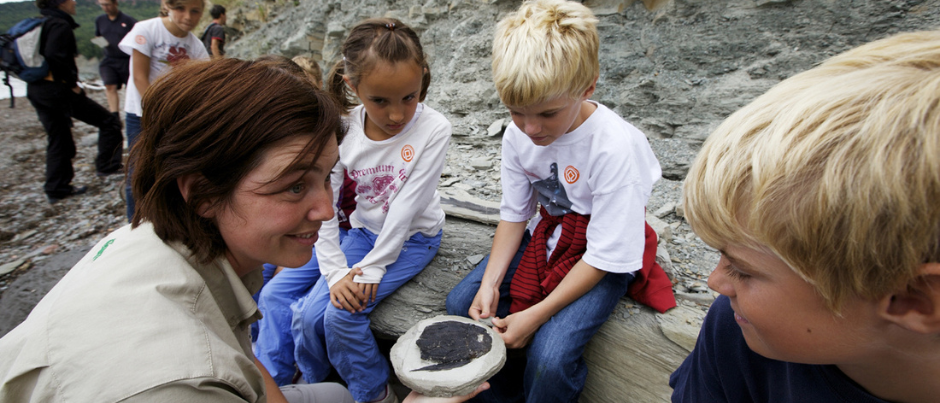The Québec maritime Blog

-
Parc national de Miguasha, Gaspésie
Robert Baronet
Parc national de Miguasha: When Fish Ruled the World
Torrents flow down from the Appalachian Mountains towards a sparkling sea. Near the coast, the wind gently stirs the branches of trees providing shade from the sun’s hot rays. Waves crash on the beach, creating a soothing sound. In the water, fish abound. At first glance, this may sound like a description of one of Gaspésie’s many enchanting coastal landscapes. In fact, it is… some 380 million years ago, in the middle of the Devonian Period. Parc national de Miguasha offers visitors the opportunity to discover what links us to this mysterious lost world, thanks to the park’s exceptional fossil collection.
A little history
The Devonian, a geologic period that many people are unfamiliar with, spanned 60 million years and marked the beginning of proper life on land. To understand this period, no fossil site in the world is considered more important than Parc national de Miguasha, which is nestled on the edge of Chaleur Bay. The park’s outstanding features have long been recognized: it has been on the prestigious UNESCO World Heritage List since 1999. When visiting Gaspésie, a stop at this paleontological mecca is a surefire source of wonder.

Thanks to the abundance of its remarkably well-preserved fossils, the Miguasha site documents a complex ecosystem associated with an ancient estuary that lay at the foot of the newly formed Appalachians. At the time, sediment eroding from these mountains accumulated at the bottom of the estuary, trapping the plants, invertebrates and fish that lived there. Now found as fossils in the park’s cliff, these remains provide insights into Devonian life.

What did this world look like? At the time, the first primitive forests were growing along waterways. Under this forest cover, no amphibians, reptiles, birds or mammals were yet present. Only scorpions, centipedes and spiders were found on land. In the waters, bizarre types of fish reigned supreme.
It was in this biological context that one of the great revolutions in the history of life was quietly taking place: the transition from fins to legs, followed by the colonization of dry land by tetrapods, or four-legged vertebrates. Tetrapods, which today include such varied species as frogs, turtles, birds, humans and whales, are all descendants of the Earth’s first vertebrates, the fish.
During the decades of scientific research conducted at the fossil site, a few Miguasha species have become iconic for paleontology due to their central importance to our understanding of this landmark chapter in evolution. Others have recently yielded exceptionally well-preserved new specimens for research and education. Here are just a few of the famous fossils you can admire during your visit to the park.
Eusthenopteron foordi

Nicknamed the Prince of Miguasha, this species has been the site’s scientific ambassador for over a century, thanks to its surprising anatomical features. For example, the internal bone structure of its front pair of fins, called pectoral fins, resembles that of the arms and forearms of tetrapods, and therefore also of humans. As a result, Eusthenopteron was the main model used by paleontologists throughout the 20th century to emphasize the kinship between fish and tetrapods. Some of the finest specimens of Eusthenopteron found at Miguasha are on display for visitors to admire in the park’s exhibition rooms.
Elpistostege watsoni

In recent years, the undisputed star of a visit to Miguasha is Elpistostege watsoni, nicknamed Elpi. First described in 1937 based on a skull fragment discovered on site, this species has finally been better documented since the discovery of an impressive complete skeleton that is 1.6 metres (5.25 feet) long and is now on display in the park.

Although covered in scales and featuring fins like other fish, Elpi also possesses almost all the characteristics of the first tetrapods: eye sockets located along the top of a flattened skull, a long snout and external nostrils that must have been connected to lungs. But Elpi’s most spectacular feature is hidden in its front pair of fins, which revealed an internal bone structure almost identical to that of the tetrapods: humerus (arm), radius and ulna (forearm) bones like its cousin Eusthenopteron but also carpals (wrists), metacarpals (hands) and phalanges organized in fingers! These characteristics make Elpistostege the closest fish to the first terrestrial vertebrates. Today, some 30,000 species of amphibians, reptiles, birds and mammals (including humans) have the same bone elements in their limbs as those found in Elpi’s fins.
Quebecius quebecensis

On-site fossil collecting continues to yield exceptional new specimens every year. A recent example is the discovery of a superb Quebecius quebecensis, one of the rarest fish species at Miguasha (the park’s collection of 16,200 fossils only includes 38 specimens of this species). Preserved in 3D, this unique fossil will be added to the exhibition in 2023.
A visit to Parc national de Miguasha connects us with our ancient aquatic origins dating back some 380 million years. The wide range of activities on offer at the cliff, in the exhibition rooms and in the educational laboratory give visitors of all ages the opportunity to discover and even experience the work of a paleontologist as well as grasp how fossils are essentially time machines we can use to visit the Earth’s past!

(0) comment